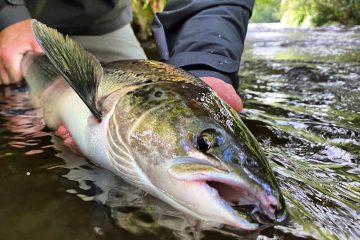If you are on a river fly fishing in Devon it means that you will probably be fishing for wild brown trout. This is certainly the case on the River Taw where no stocking of fish takes place. There is always the chance that the fish that has just risen to your dry fly has never been caught before and has certainly never seen a hatchery!
The fish you will be catching on the River Taw are generally in the 6 to 10 inch range with a 12 incher being a fish to be proud of. Often larger fish are caught and the 2010 season saw a fish of 17 inches come to the net. Although rare, it is hard to walk past a pool without thinking of that big brown just sliding under the bank edge out of view. Every now and then though they can be tempted out!
It might be easy to think that these fish are only small, but given their environment they have done well to escape predation and survive on the little food there is on offer. The reason for the lack of food is that the Taw, along with many rivers throughout the country, are fed by rainfall making them spate rivers. Spate rivers are generally acidic, compared to chalkstreams that are rich in nutrients and the perfect environments for lush weed growth. This in turn means a good environment for insect life, which again means a healthy larder for the fish so that they can grow larger.
That having been said spate rivers do enjoy excellent hatches of insects and dry fly fishing is often spectacular. The Taw has been experiencing an excellent mayfly hatch of late.
As food is not as readily available as on chalkstreams, the fish have make a descision quickly on a well presented fly and so the fly angler needs to be prepared for an immediate response. The take is generally pretty quick and you are looking to cover water looking for a taking fish!
The Devon School of Fly Fishing operates on over 7 miles of the river Taw and offers guiding and tuition for beginners to advanced.


